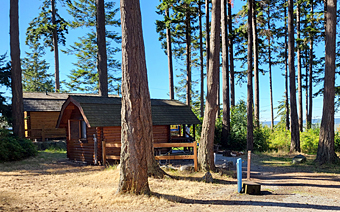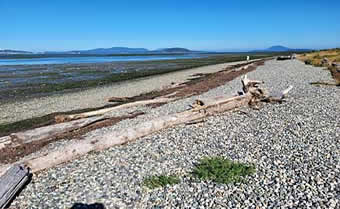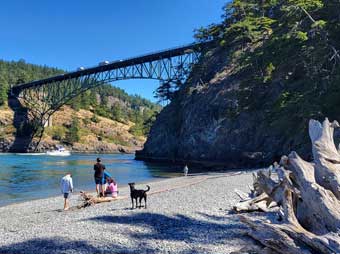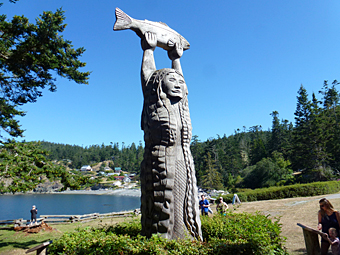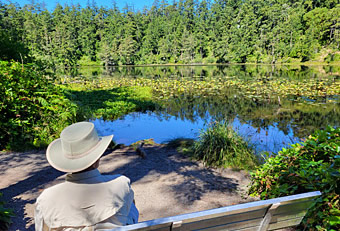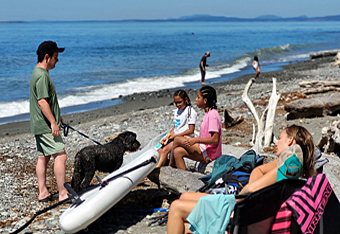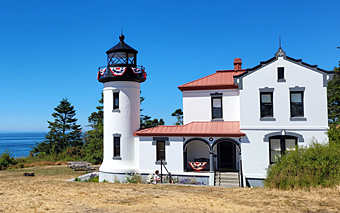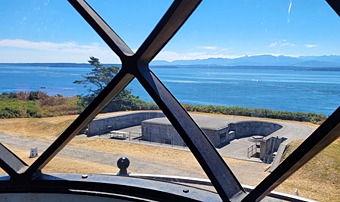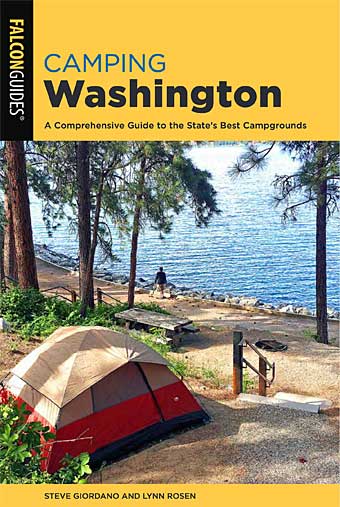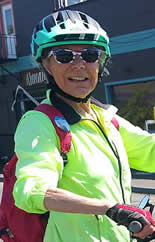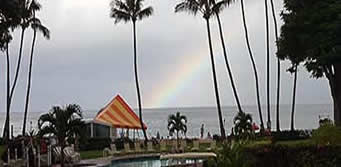 |
|
GETAWAY CAMPING IN WESTERN WASHINGTON Story by Lynn Rosen and photos by Lynn Rosen and Steve Giordano |
|||
Everybody’s ready for a camping getaway, especially right now before the chill of fall weather hits. We’ll share just a few of our best getaway camping spots along the Western side of Washington, the state where camping is practically the official state sport. BAY VIEW STATE PARK
Cabins at Bay View State Park are nestled among Douglas fir trees with spectacular views of Padilla Bay and the San Juan Islands and are within walking distance of the park’s beach and Padilla Bay. Each cabin has one double and two single beds as well as a refrigerator with freezer. Some also have sinks, toilets and showers. Pets are allowed with a $15 (plus tax) fee per night. This 25-acre park was formerly a baseball field, a racetrack, and a local picnic area. It features a grassy expanse plus 1,285 feet of saltwater shoreline on Padilla Bay. The camping area sits on a hill above the road. To get to the gravel beach, you must walk through a roadway underpass. This stretch of beach, part of the Padilla Bay National Estuarine Research Reserve, connects with the Padilla Bay Trail to form an 8-mile shoreline walk. Check for shellfish-harvesting closures. DECEPTION PASS STATE PARK
Deception Pass is Washington's most-visited state park for a reason. Mysterious coves, rugged cliffs, jaw-dropping sunsets, and a stomach-dropping, iconic, high bridge make this park a go-to for locals and international travelers alike. This park straddles Deception Pass, encompassing 4,134 acres on the northern tip of Whidbey Island (in Island County) and the southern tip of Fidalgo Island (in Skagit County). The most popular state park in Washington, Deception Pass in 2022 celebrated its 100th birthday. The tide surges through the pass too swiftly for paddlers to navigate against the currents, but the rushing water provides a spectacle for onlookers on the 182-foot-high bridge that spans the pass. Camping is located in three sites in the park: Bowman Bay, Quarry Pond, and Cranberry Lake. The state park features a few lakes, some old-growth Douglas fir forests, marshland, sand dunes, and a few smaller islands. There are 35 miles of hiking trails and a 1.5-mile interpretive trail, as well as 15 miles of saltwater shoreline with rocky bluffs, coves, tidal flats, and sandy beaches. The Maiden of Deception Pass story pole, which stands above the park’s Rosario Beach, depicts the guardian of the sea, Ko-kwal-awoot, who looks over her Samish people. This iconic carving by local artist, Tracey Powel, shows her two sides: the beautiful maiden on one side and her life in the sea on the other. It was placed here in 1983 and dedicated by the Samish. Black-tailed deer are common here, and bald eagles nest in the treetops. The Civilian Conservation Corps Interpretive Center is located in the Bowman Bay area of the park. Noise alert: US Navy Growler jets from nearby Naval Air Station Whidbey Island may fly maneuvers over the campground at any time. FORT EBEY STATE PARK
Part of Ebey’s Landing National Historical Reserve, Fort Ebey sits on the bluffs high above the Strait of Juan de Fuca, where the strait flows into Admiralty Inlet. There are 24 picnic sites in the day-use area. The 645-acre park offers 3 miles of bluff trails and 1.5 miles of beach trails. Follow the driftwood-strewn beach and look for Japanese glass fishing floats. It is interesting to explore the gun batteries and bunkers that remain from the days when the fort was operational. FORT CASEY STATE PARK
Fort Casey State Park (including Keystone Spit) encompasses 467 acres and offers 7,000 feet of freshwater frontage on Crockett Lake and 10,810 feet of saltwater shoreline on Admiralty Inlet. It is the site of the historic Admiralty Head Lighthouse. Established in the late 1890s as a US Coast Guard artillery fort, Fort Casey was incorporated into Ebey’s Landing National Historical Reserve by the National Park Service in 1980. Old gunnery fortifications are still in place. The beach on the west side of the campground is fine for walks and exploring. Occasionally, you can see whales from both Fort Casey and Ebey’s Landing. Pods of orcas that stray from their usual waters around the San Juan Islands are the most fun to see, but there are plenty of river otters, harbor seals, and California sea lions as well. Dolphins, minke whales, and humpback whales are less commonly sighted. In late spring and early summer, you may see gray whales migrating from California to the Arctic. You can walk north along the beach for 4 miles to Fort Ebey (see above). Noise alert: US Navy jets from nearby Naval Air Station Whidbey Island may fly maneuvers over the campground at any time.
For more information about camping in Washington, visit https://www.parks.wa.gov/ Annual National Public Lands Day National Public Lands Day this year is on Saturday, September 24th, 2022 and entry fees will be waived at national parks and other federal public lands, including national monuments, forests, recreation areas, seashores, wildlife refuges, historical sites, battlefields, and grasslands. More than just a great day for a visit, National Public Lands Day is also the nation’s largest single day of volunteering for parks and public lands. People can find 500 volunteer events in almost every state at national, state, local parks or other public lands through this interactive map: https://www.neefusa.org/npld-event-search. More than one million people have volunteered on National Public Lands Day over the past decade. About the Author
|
